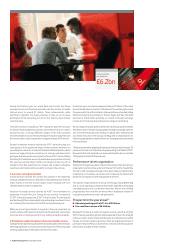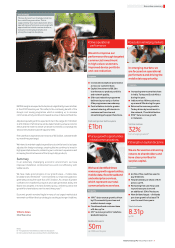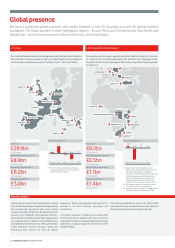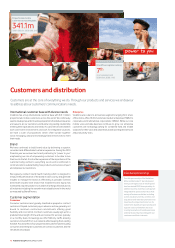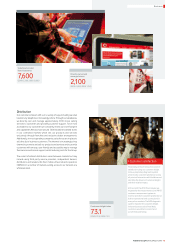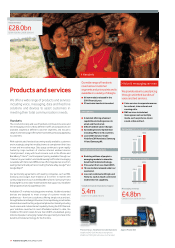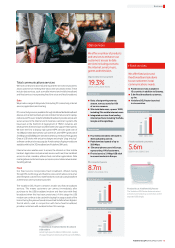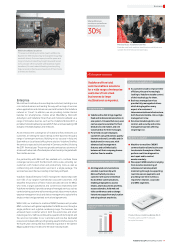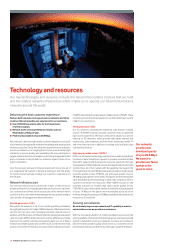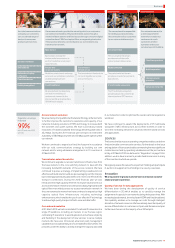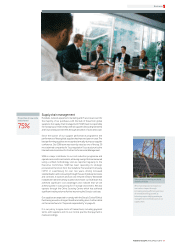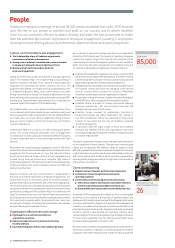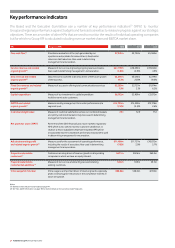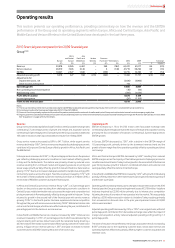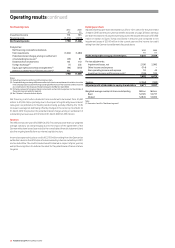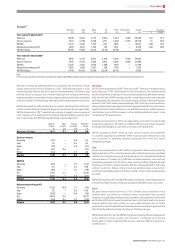Vodafone 2010 Annual Report Download - page 20
Download and view the complete annual report
Please find page 20 of the 2010 Vodafone annual report below. You can navigate through the pages in the report by either clicking on the pages listed below, or by using the keyword search tool below to find specific information within the annual report.
18 Vodafone Group Plc Annual Report 2010
Our key technologies and resources include the telecommunications licences that we hold
and the related network infrastructure which enable us to operate our telecommunications
networks around the world.
Technology and resources
Delivering the best customer experience
We have built extensive coverage across our networks and strive
to deliver the best possible user experience for our customers.
Over 200,000 base station sites for the transmission
of wireless signals.
Network traffic of nearly 700 billion minutes and over
90 petabytes of data per year.
Peak download speeds of up to 28.8 Mbps.
We continue to deliver a high quality customer experience across all
of our markets, leveraging the extensive knowledge and expertise that
we have across the Group. We measure key performance indicators
across our markets on an ongoing basis to ensure we maintain high
standards of service quality and availability. We also participate in
regular network drive test campaigns conducted by independent third
party companies to benchmark our networks against those of our
major competitors.
Over the last year we have introduced advanced tools across all of
our established 3G markets in Europe providing us with the ability
to monitor and proactively manage our customers’ experience on
the network.
Network infrastructure
Our network infrastructure provides the means of delivering our
mobile and fixed voice, messaging and data services to our customers.
Our customers are linked via the access part of the network which
connects to the core network that manages the set-up and routing of
calls, transfer of messages and data connections.
Second generation (‘2G’)
We operate 2G networks in all of our mobile operating subsidiaries
through global system for mobile (‘GSM’) networks, offering customers
services such as voice, text messaging and basic data services. In
addition, all of the Group’s controlled net works operate general packet
radio services (‘GPRS’), often referred to as 2.5G. GPRS allows mobile
devices to be used for sending and receiving data over an IP based
network and enabling data service offers such as internet and email
access. In a number of networks, we also provide an advanced version
of GPRS called enhanced data rates for GSM evolution (‘EDGE’). These
networks provide download speeds of over 200 kilobits per second
(‘kbps’) to our customers.
Third generation (‘3G’)
Our 3G networks, operating the wideband code division multiple
access (‘W-CDMA’) standard, provide customers with an optimised
data access experience. We have continued to expand our service
offering on 3G networks, which provide high speed internet and
email access, video telephony, full track music downloads, mobile TV
and other data services in addition to existing voice and basic data
connectivity services.
High speed packet access (‘HSPA’)
HSPA is a 3G wireless technology enhancement enabling significant
increases in data transmission speeds. It provides increased mobile
data traffic capacity and improves the customer experience through
the availability of 3G broadband services and significantly shorter data
transfer times. All of our markets with 3G capability now support the
3.6 mega bits per second (‘Mbps’) peak speed evolution of high speed
downlink packet access (‘HSDPA’) and with peak speeds of up to
28.8 Mbps peak speed in some areas. The figures are theoretical peak
rates deliverable by the technology in ideal radio conditions with no
customer contention for resources. While HSDPA focuses on the
downlink (network to mobile), high speed uplink packet access
(‘HSUPA’) focuses on the uplink (mobile to network) and peak speeds
of up to 1.4 Mbps on the uplink are now available across all of our
markets, with peak speeds up to 5.8 Mbps available in key areas across
many of our 3G networks.
Evolving our networks
We continually improve our network and IT capability in order to
enhance the service we provide our customers.
With the increasing adoption of mobile broadband services and the
wider availability of advanced smartphones we are seeing accelerated
growth in data traffic across our networks. To ensure we continue to
deliver the best possible quality of service to our customers we are
proactively evolving our infrastructure through a range of initiatives.
Our networks
provide peak
download speeds
of up to 28.8 Mbps.
We expect to
provide ever faster
speeds in the
years to come.


